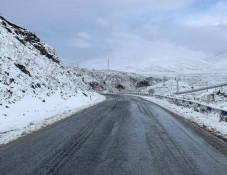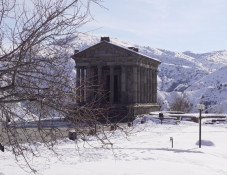
Rouben Galichian references C9-14th Islamic sources about Armenia and Armenians
When the Arabs invaded the civilised cultures of the Middle East and Iran, they had the foresight to allow local scholars and scientists to continue and develop their work in science and the arts. It was during this period that most of the classical Greco-Roman literary works were translated into Arabic, the international language of Islam, according to the famous cartographer Rouben Galichian’s book Historical and Geographical Falsifications of Azerbaijan, a historical, cultural and cartographical research based on a detailed analysis backed by documentary evidence.
One of the most important pioneers in Islamic geography, and the founder of the Balkhi School of cartography, was Abu Zaid Ibn Sahl al-Balkhi (850-934 CE). Other important geographers were Ishaq Ibn Muhammad al-Istakhri (died 857), Abu Rayhan Biruni (872-1048), Zakaria Ibn Muhammad al-Qazvini (1203-1283), Hamdallah Mostowfi al-Qazvini (1281-1339) and many others, according to Galichian.
Arab explorers travelled the world and wrote detailed reports about their journeys and encounters actually expanding and complimenting the existing Arab knowledge of the contemporary world. These include Ibn Battuta (1304-1368/9) who travelled through the Caspian Sea (1330-1335), Russia, Central Asia, China, India (1345-1349) and other countries.
“In Islamic geographical and cartographic descriptions and related maps of the countries in the South Caucasus it is obvious that from their point of view Azerbaijan was the Iranian province situated south of the River Araks, while Aghvank was a separate country or province located north of the rivers Kura and Araks, and that the two had distinctly separate and different peoples, cultures and even religions. The third country present in the region is Armenia, with its capital Dvin (in Arabic, Dabil). In various geography books by different authors, all the toponyms of the cities and villages of these three countries match each other closely with very few exceptions,” Galichian writes.
Further, he refers to maps created by Islamic geographers and the texts they accompany. He analyses the written geographic and historic evidence provided in them.
According to Ahmed Ibn Yahya al-Baladhuri, one of oldest Islamic historians and geographers, Azerbaijan was one of the Iranian provinces, which he writes in his Kitab al-Futuh al-Buldan (Book of the Conquests of the Countries) in the chapter entitled ‘The Conquest of Azerbaijan.’
“Hussein Ibn Abru from Ardabil relates how Omar Ibn Khattab appointed Hadhifat Bin al-Yamani as the ruler of Azerbaijan. ... When Hadhifat received his orders, he went to the city of Ardabil in Azerbaijan, where the collector of taxes, the Marzban resided. But meanwhile the Marzban managed to conscript fighters from the Azerbaijani cities of Bajervan, Maymand, Narin, Sarab, Mianeh and other cities. This army fought fiercely against the Islamic forces of Hadhifat,” Galichian cites the Ilsmaic geographer and notes that the fact that al-Baladhuri writes the above-mentioned cities as Azerbaijani shows that it was the area the Arabs considered Azerbaijan.
In the same book, in the chapter ‘The Conquest of Armenia,’ he names the Armenian cities of Samosata, Qalikla, Khlat, Arjesh, Jurzan, Sisakan, Bagrevand and Dvin.
Ninth century Persian geographer Ibn Khordadbeh, who is one of the most renowned Islamic scholars, refers to Aghvank (Arran) and Azerbaijan in his Kitab al-Masalik wa al-Mamalik (The Book of Roads and Kingdoms) as follows: “The countries of Arran, Sisjan and Gurjan are part of the lands of the Casps, which Anushirvan conquered.” Elsewhere in the same book he writes: “In the north, which constitutes one quarter of Persia, there ruled a leader called Adapatkan. This region consists of Armenia, Azerbaijan, Rey, and Demavand, whose important town is Shalanba…”
Ibn Khordadbeh lists the following towns as belonging to the province of Azerbaijan: Maragha, Mianj [Mianeh], Ardabil, Varthan [Varzakan] (located on the borders of Armenia and Azerbaijan), Tabriz, Marand, Khoy, Moghan, Barzand, Jabervan, Urmia and Salmast.
“All the above towns have been and still are in the Iranian Province of Azerbaijan, which again shows that Azerbaijan was always an Iranian province. Even in modern maps, the city of Varthan, placed between Armenia and Iran of the time, is 50km north of Tabriz and 40km south of the Araks, i.e. in the position as described in the medieval text,” Galichian writes. He points out that Ibn Khordadbeh allots three pages to the country of Aghvank (Arran, Albania, – ed.), while Armenia merits more than twenty pages of descriptions, which is an indicator of the geographical, trading and political importance of the lands in question.
Remarkably, on a South Caucasus map in Ibn Khordadbeh’s Russian translation, published in Baku in 1986, Armenia is shown as stretching from Lake Van to past Sevan, Azerbaijan is placed south of the River Araks down to Lake Urmia. North of Azerbaijan, the regions of Aghvank, namely Moghan, Shirvan, Shaki and Tabaristan are to be found, but the name Aghvank is not mentioned.
“Abu Zaid Sahl al-Balkhi (850-934) is one of the leading Islamic cartographers after whom the Islamic cartographic school was named. A scholar and mathematician, he lived in Baghdad but in the later stage of his life moved to the Central Asian city of Balkh, in present-day Afghanistan, where he produced most of his important geographical works,” Galichian writes.
Many Islamic geography books contain world maps, but when it comes to separate maps for geographical regions, they generally represent the countries and regions only belonging to the Islamic world. One of the Persian geographers, al-Muqaddasi (945 – app. 1000), explains: “We have written here only about the realm of Islam; we do not bother ourselves with the countries of the unbelievers, because we did not enter them, and we see no use whatever in describing them: of course we mention those areas among them where Muslims are settled.”
According to Galichian, in the Balkhi School, the regional maps concentrate mainly on the Persian provinces, as well as some of those of Middle East and Central Asia. These include separate maps of Arabia, Fars, Maghrib, Kirman, Iraq, Jazira (Mesopotamia), Pars, Khuzistan, Sistan, Sind, Hind (India), Khazar, Deylam and Tabaristan, Khwarazm, Misr, Sham (Syria), which are inserted after the world map. On the world map itself, some of the non-Islamic countries are also shown, such as Andalus, Rum (Byzantium or Roman Empire), Bulgaria, Russia, Aghvank, Saqaliba, Armenia, India and China. Regarding the smaller-scale regional maps, generally there were none prepared for the non-Islamic regions with the exception of Aghvank and Armenia, which were the neighbours of the Iranian province of Azerbaijan, situated south of the River Araks, and hence were included in a map depicting that region. As a rule, this regional map is always entitled ‘Map of Armenia, Atropatene (Atrpatakan) and Albania (Aghvank).’
“In this sort of map showing the countries south of the Caucasus, the provinces of Iberia and Colchis are not mentioned, while Azerbaijan/ Atropatene without exception is shown as the north-western province of Iran, south of the Araks. Aghvank is always present with its Persian-Arabic name Arran, perhaps the reason being that during the seventh to eighth centuries the population of this land was in the process of converting to Islam and thus joining the Islamic camp,” Galichian writes.
The three countries of the South Caucasus are placed as follows: Aghvank—lying on both banks of the Kura, extending from Tiflis to the Caspian Sea; Atrpatakan—south of the Araks and east of Lake Urmia; Armenia—north and south of the Araks, west of Lake Urmia.
The Arab geographer Abu al-Fida (or Abul-Fida) in his Taqwim al-Buldan (Sketch of the Countries) makes the following observation: “As these three provinces are closely related, scholars place them in one single map and describe them in one chapter.”
Ibn al-Faqih Hamadani (10th century), a Persian historian and geographer, wrote his Mukhtasar al-Buldan (Concise Book of Provinces), which is one of the most important historical and geographical documents of the Islamic world. He was born in the Persian city of Hamadan, which, as claimed by Azerbaijani researchers Igrar Aliyev and Farida Mammadova, in medieval times was one of the cities of ancient Aghvank (Albania). Mukhtasar al-Buldan contains two pages describing Arran, three pages for Azerbaijan, and seventeen pages for Armenia, Galichian notes.
“In the case of Azerbaijan, the author states that it stretches from Barda’a to Zanjan, almost corresponding to the correct extent of the Iranian province of Atrpatakan. Within this province he mentions the cities of Salmast, Moqan, Khoy, Varsakan, Baylakan, Maragha, Neiriz and Tabriz. Ibn al-Faqih places the following cities within the territory of Armenia: Barda’a, Shaki, Kapaghak (Qabala), Dvin, Bagrevan, Nakhijevan, Khlat, Arjesh and Qalikla (Erzrum). On Arran he mentions only that the Rivers Araks and Kura pass through it, and that the city of Baylakan can be found there,” Galichian points out.
Abu al-Hasan Ali Ibn Husein Ali al-Mas’udi (896-956), Baghdad-born historian and geographer, writes the following on the Caucasus and neighbouring areas: “Men are placed here …. because the nomadic Ghuzz [Oghuz] Turks set up their winter camp in these parts. As the water courses that link the river of the Khazars with the Strait of Pontus are often frozen, the Ghuzz cross them with their horses, […] and thus they raid into the land of the Khazars. At the head of one of these passes is the city of Derbend, built by Chosroe Anushirvan in a place between the mountains and the Sea of the Khazars [Caspian Sea]. ... Had their rulers not aided Iran in founding the city of Derbend and constructing these ramparts [Chora Pahak], […] there is no doubt that the rulers of Georgia, the Alans, the Avars, the Turks and other nations we have named would have invaded the territories of Bardha’a [Partav], Albania [Aghvank], Baylaqan, Azerbaijan, Zanjan, Abhar, Qazvin, Ramadan, Dinawar, Nihawand and the frontiers of the dependencies of Kufa and Basra…”
Galichian writes that although the Turkic tribes were unable to conquer the South Caucasus in the 9th century, they eventually reached the areas Mas’udi mentions, Aghvank, Azerbaijan, as well as Armenian cities and regions. “The invading tribes began with plundering the region, gradually establishing themselves as its overlords. The present-day Azerbaijanis now claim to be indigenous to this region, calling themselves one of the oldest people inhabiting the area, relegating the Armenians as newcomers,” he highlights.
With slight variations, the Arab geographer Abu Ishak Ibrahim ibn Muhamad al-Farisi al-Istakhri (died in 957) repeats the same, whose main work is Kitab al-Masalik w'al- Mamalik (The Book of Roads and Kingdoms) (http://www.panorama.am/en/region/2015/08/24/history1/).
“The extant manuscripts of the volume contain 19-21 maps. Texts with detailed information on the geography and peoples of the depicted countries are attached to each map. The chapter on the countries south of the Caucasus is entitled ‘Concerning Armenia, Arran and Azerbaijan,’ where those three countries, their cities, rivers, lakes and mountains are described,” Galichian writes.
Here is what the Arab geographer writes about the cities of that country: “Azerbaijan: The largest town is Ardabil. Other cities are Maragha, Urmiya, Mianeh, Dehkharqan, Salmast, Nashui, Marand, Tabriz, Barzand, Moqan, Jabervan, Ushneh and other smaller ones. Arran: Barda’a is its largest town. Others are Bab al-Abwab [Derbend], Tiflis, Baylaqan, Varthan, Shamakhi, Abkhaz, Shaberan, Qabala, Shaki, Ganja, Shamkhor and other smaller ones. Armenia: Dabil is the capital which is larger than Ardabil. Other cities are Nakhichevan, Berkri, Khlat, Manazkert, Varzan, Bitlis, Qalikla, Arzan, Miafarqin and Saraj, which all are bustling.”
Galichian further refers to Abulqasim Muhammad Ibn Hawqal (travelled between 943 and 978), the author of one of the most ancient Islamic geographic works entitled Surat al-Ard (The Face of the Earth), which contains 21 maps with detailed descriptions; an anonymous author’s geographic manuscript Hodud al-Alam (The Regions of the World), written originally in Persian around 982 CE and translated with an extensive commentary by the Russian orientalist Vladimir Minorsky; Muhammad Ibn Ahmad Shamsuddin al-Muqaddasi (945-1000) , another respected Persian-Islamic geographer, whose simple maps show major countries, cities and the roads connecting various regions. “His Ahsan al-Taqasim fi Ma’rafat al-Aqalim (The Best Divisions for Knowledge of the Regions) contains a great deal of information about countries, regions, provinces and the people living in these parts, as well as twenty simple maps. Originally written in Arabic, it was also translated into Farsi, al-Muqaddasi’s native language,” Galichian writes.
Galichian’s book also includes the works of Abul-Fida (1273-1331), an Arab historian and geographer, whose most important work is Taqwim al-Buldan (Description of the Regions) and Hamdallah Mostowfi al-Qazvini (1281-1349), whose Nozhat al-Qolub (Heart ’s Bliss) contains data on the geography of Muslim countries including their cities and populations.
To be continued.
Born in Tabriz, Rouben Galichian is a descendant of refugees from Van who survived the Genocide. He received scholarship and studied engineering at Aston University, Birmingham (UK). Since in 1981, he started to study the rich cartographical heritage in the libraries of the UK and other European countries. His first research, Historic Maps of Armenia (in English), was published in 2004. It was a collection of maps from various libraries and museums in the world, where Armenia was noted, beginning from the 6th century to the present times. His second book, Armenia in World Cartography, was published in Yerevan in 2005. The research ‘Countries South of the Caucasus in Medieval Maps. Armenia, Georgia and Azerbaijan’ (in English and Armenian) was published in 2007. The book The Invention of History (in English) was published in 2009.
In his book Historical and Geographical Falsifications of Azerbaijan, published in 2013, the author details the reasons, aims and methodology of the falsification of the history of Azerbaijan and the countries of the region.
Related news
- Rouben Galichian compiles evidence on Armenian presence in Caucasus from Greco-Roman sources of C5-1 BC
- Rouben Galichian refutes Azerbaijani theory about ‘Armenians being newcomers’ to South Caucasus
- Rouben Galichian exposes myth of ‘divided Azerbaijan’ and Azerbaijani scientists’ falsifications of sources
- Rouben Galichian exposes Azerbaijani historiography’s contradictions to sources and even its own theories
- Rouben Galichian: Azari is Iranian dialect, Turkic language was introduced in region of in C11 with nomad Oghuzes
- Rouben Galichian: For Azerbaijani historians, issues of their people’s origin are flexible and alterable theories
- Rouben Galichian: Falsification of Azerbaijan’s history begins from school textbooks and youth believes in that lie
- Historical and Geographical Falsifications of Azerbaijan. Rouben Galichian argues on aims of appropriating others’ history
Newsfeed
Videos






























